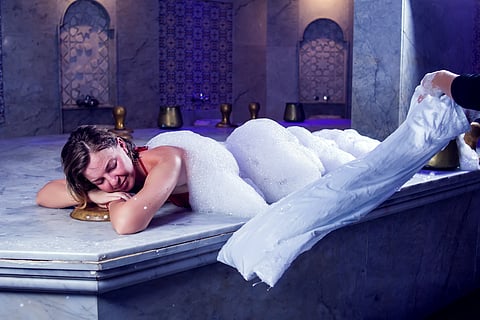
- Destinations
- Experiences
- Stay
- What's new
- Celebrating People
- Responsible Tourism
- CampaignsCampaigns
- Subscribe
- Buy Now

Türkiye’s hammams, or bathhouses, are a ubiquitous part of their culture, much like the saunas are to the Finns and the hot springs are to the Japanese. The Romans, lacking showers and baths at home, created a widespread system of public baths, which became central to towns and villages across their empire. Everyone went to the baths as they were a place to socialise and bathe.
With the start of the Ottoman Era, many baths were built in the style of Islamic culture. Thus, the baths, which are segregated by gender, became a place to cleanse oneself completely, and many hammams came to be built close to mosques so that local worshippers could cleanse themselves before prayer.
Here’s what you should know about visiting a hammam in Türkiye.
Hammams, like saunas, circulate hot air and are typically made of marble. They consist of an outer warm chamber, a hot inner chamber and an outer cooler chamber for relaxing post-steam (the layout may vary from place to place). In İstanbul, there are a number of beautifully designed Ottoman hammams that date back to the 15th and 17th centuries. These are typically ornate and traditionally feature multiple chambers, marble floors, marble seating, and the traditional marble göbek taşı in the centre—where bathers are washed and scrubbed by attendants.
Though they are no longer part of most people’s daily or weekly routine, hammam visits are still popular among both men and women during pre-wedding festivities and for other special occasions. Others go for the health benefits, which are reputed to include improved blood flow, skin texture, lower stress levels and muscle relaxation.
When you arrive at a hammam, you will have to choose which package you’d like, such as a self-service, soap or scrub, massage, waxing or any other beauty treatment. Depending on the package chosen, the assistant will supply you with tokens or wristbands and will give you a personal kessa (scrubbing mitt), peshtemal (a towel to be worn inside) and a pair of disposable underwear.
After disrobing in a locker and putting away your things, put on the underwear and wrap the peshtemal around yourself. Walking into the warm outer chambers, you’ll typically be directed to wooden sandals that will prevent you from slipping. Inside, there’ll be raised seating to relax and take in the heat, along with metal dishes to douse yourself with cold water to shock the skin. If you’ve elected to have a scrub, you’ll be ushered into the next room, which is hotter and features a central marble slab for relaxing, the göbek taşı.
Using your kessa, the tellak (masseuse) will scrub away at your skin. This can be a bit of a rough procedure but it’s quite normal. Next, you’ll be ushered to the göbek taşı for the soaping. Prepare to be completely covered in a rich lather before being doused with cold water as you rinse off.
If you’ve elected to have a massage, the assistant will let you know when there’s a masseuse available. Take note that in most hammams where massages are available, there may be other people getting massaged at the same time rather than a solo spa-style massage.
After you’ve had enough of a steam, relax with a tea or cool drink in the inner relaxation area.
Consider the Hurrem Sultan Hammam, the Ali Paşa Hamamı, the Zeyrek Çinili Hamam, the Çemberlitaş Hamamı and the Kadırga Hamam for the experience.
